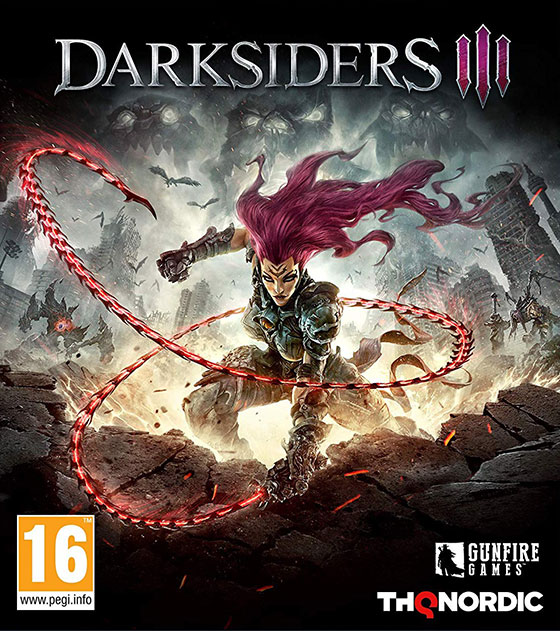‘Darksiders III’ Review (PC)

Finally, the long-overdue latest instalment in the revered action RPG series is here. This one has been developed by Gunfire Games, a team born from the ashes of Vigil Games. Gunfire worked on the “Deathinitive Edition” of Darksiders II – a game which, I’m sorry to report, retains its title as the best in the series so far.
In Darksiders III you’re Fury, Horseman of the Apocalypse with anger management issues. One day, she is hanging out with her horse, Rampage, when she gets the call from The Charred Council – their role is to maintain balance in the universe, lest we forget – who task her with heading to a ravaged Earth to defeat the Seven Deadly Sins. En route, Fury bumps into the Lord of the Hollows, who claims that the Council is deceiving her. But could he be the deceiver? Either way, she’s going to smash some skulls.
The Seven are the bosses, of course, and they represent the high point of the game’s sumptuous creature design. I particularly enjoyed Avarice, whose chamber is a treasure trove of hoarded knick-knacks, and who batters you with an old bathtub. Sloth is a grotesque giant, who heaves from a throne carried by giant beetles. And there’s Pride, doing her best Cate Blanchett from Thor Ragnarok, smug in her great floating fortress.
Pride is very much at the Bayonetta end of the stylistic spectrum, which is apt because Darksiders III’s combat is pushing for something similarly elegant to PlatinumGames’ masterpiece. It fails hard, to the point where I went back to the previous games to check the combat wasn’t always this clunky. The first two games tended toward more of a crowds ‘n’ combos approach, but the controls were slick and responsive. By comparison, regardless of your controller dexterity, Fury never feels entirely equipped for the job. All her chain-whipping, backflipping and spinning counters have the look of a gun-witch but none of the basic mechanical fluidity.
Perhaps this explains why Gunfire opted for such overpowered special forms. Build wrath and you can go on the rampage, dealing super damage with extra speed – and it’s pretty much a necessity if more than one enemy is coming at you. Rarer still is Chaos form, which sees Fury grow to twice her size and do immense damage whilst being invulnerable. Chaos is great fun, but so slow to build up that I just saved it for the bosses.
The bread and butter combat is quicker than the previous games, and in some ways more sophisticated. You still have the combos, and your primary attacks are still the standard X-button slash and the Y-button secondary. But now a key part of combat is the dodge: time it right and time briefly slows, allowing you to deliver a powerful counter. It works brilliantly against a single opponent, after you’ve learned their attacks. But later, when mobs come in packs, it’s effectively useless due to staggered incoming strikes.
Indeed, it’s entirely possible to be pinned down by multiple enemies without retaliation until you’re dead, even on the easiest difficulty. Gunfire seem to be taking some inspiration from Dark Souls here. There are fewer monsters stalking these ruins and they hit harder. Darksiders III is a devilishly tough game. This would be fine, but when you combine it with cheap tricks – say, enemies attacking you as you climb onto ledges, or creatures leaping out of innocuous objects and from around blind corners – your inevitable backtracking ends up being a process of avoidance, which seems ridiculous for a legendary being wishing to live up to her name.
Yes, backtracking makes its unwelcome return, and here we must discuss navigation. As before, the player is traversing a vast, complex, interconnected environment. Moreover, the Seven Deadly can be tackled in almost any order. But there is no map. At all. Your sole means of finding the next boss is a compass marker. Except this only works on a single plane, which makes it next to useless. There are always Vulgrim’s Serpent Holes (not a euphemism) which allow fast travel. But as you’ve no cartographic context, these are worthless also. Put simply: lose your bearings and you will be treated to a merry old goose chase.
The environmental design just isn’t quite good enough to naturally lead you through a coherent adventure. There are times when I found myself confronted by a new monster – with a new, vicious set of attacks – for the first time, in a tiny, enclosed space. Where is sense of occasion? The drama? More importantly, where is the clever design that introduces the player to this new foe and gives them a chance to learn their attacks? No, Darksiders III is happy to plonk new enemies into its bestiary with zero ceremony.
As you progress, paths in the environment will open to you via the tried and tested Metroidvania approach of new skills offering new options. Your secondary weapon is dictated by your elemental form. Forms – flame, storm, stasis etc – are unlocked naturally through progress, and they effectively unlock new areas by allowing you to manipulate the environment. For example, cobwebs can be burned, or chasms can be floated across. The elements mean that weapon pickups are a thing of the past. However, your primary and secondary weapons can be upgraded by good ol’ Ulthane the blacksmith. He’s also gathering human survivors, who act as special pickups throughout your journey.
Also absent is all that lovely wall-running and roof-climbing from the second game. Fury can use her primary weapon, the chain whip, to swing across certain chasms, but it’s a nerve-wracking experience – sometimes it won’t register the command because you’re not quite at the right height, or at slightly the wrong angle; and so you fall into a pit, losing a chunk of health. Grabbing ledges is similarly unreliable. It all feels a bit PS2.
Puzzles return in light form, with many relying on bomb-bugs. This can be a wearying experience. You pick up the bomb-bug and bring it to feed at a specific spot. Depending on what it feeds on, when you pick it back up you can use it to destroy certain colour-coded walls. These puzzles can be annoyingly obtuse, and the frustration is only increased by the sluggish nature of their setup, plus the fact that the bomb-bugs themselves can harm you.
And if you get stuck, all I can say is good luck. Your sarcastic sidekick, Watcher, is the least useful companion in gaming history. There’s got to be a balance between “Hey, listen!” every ten seconds and never uttering a peep even when the player has been struggling with a puzzle for thirty minutes. She’s just there for story exposition, really.
The age-old Darksiders tradition of catastrophic bugs rears its ugly head, due to the devs’ continuing insistence on using a single save state. I’ve yet to find anything to irrevocably break the game, but on one occasion the scenery failed to load in and I was trapped in the ether. Without the option to load an alternative save, or even return to the last checkpoint, I had use the task manager. Another time, I got a hard crash due to a “fatal error”. And there was a particularly strange situation where all of the enemies ceased attacking me – I got some decent progress done that day, let me tell you!
The graphics are bold and crisp and a step up from previous instalments, even if they aren’t best in class. The heightened art design is highly scaleable, Blizzard-like in its colour and smoothness, although the style suffers when the realistic-looking humans are on screen. They seem rather stiff by comparison – another disappointing callback to former gaming generations. As far as environments go, sometimes they are dazzling: the sight of colossal tree-branches breaking through shattered skyscrapers is awe-inspiring. But for much of the game you will be crawling through samey-looking grey subways and sewers.
Voice acting is decent across the board. Fury is perennially perturbed, and gets some decent banter with her sarcastic Watcher friend. Fury has more personality than War, though by her nature she is less appealing and nuanced than Darksiders II’s fantastically droll Death.
In summary, Darksiders III improves upon its predecessors in visual terms, and is their match in terms of art design. But there is a host of issues holding it back from being the sequel we wished for: the stop-start pacing; the simple yet tediously obscure puzzles, which feel like an afterthought; the one-note main character; the clumsy, unresponsive controls and the unreliable traversal; the weirdly absent tutorial; and the absolutely maddening navigation.
Since the last Darksiders we’ve had a range of classic combo-brawlers – Nier Automata, Bayonetta 2, God of War – so for Darksiders III to not even be as slick, accessible or playable as its own predecessor is a serious disappointment. It takes away more – particularly RPG elements – than it adds to the series. Therefore, it’s hard to recommend it to fans, outside of a sale; and if you are a newcomer, I would urge you to start with the upgraded editions of the first two games before considering this.
Darksiders III is out on Windows, PlayStation 4 and Xbox One from today, 27th November 2018.











































